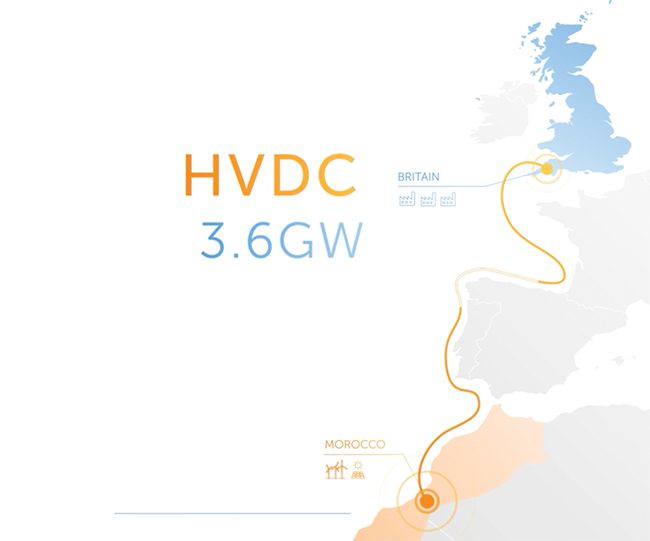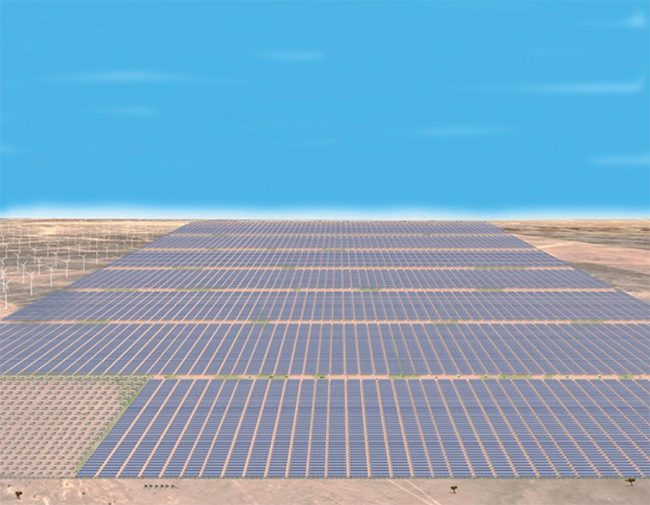Undersea Cable Projects to Transmit Renewable Energy Move Forward
Government officials in the UK have shown further support for a plan to bring renewable energy from a massive project in Morocco to Britain, one of at least three projects worldwide in which miles-long subsea cables would deliver power from solar and wind farms sited far from where much of the electricity would be used.
Xlinks, the UK-based developer of an undersea cable that would bring wind and solar power from the North African country to a site in Devon in the southwestern region of the UK, in late September said its strategy has been named a Nationally Significant Infrastructure Project. That means the British government, rather than local officials, now has jurisdiction over the installation.
 |
|
1. A project led by UK-based Xlinks that would bring renewable energy from Morocco to Britain received more support from British officials. Subsea cables will move 3.6 GW of electricity from solar and wind in North Africa to a site at Devon in the UK. Courtesy: Xlinks |
Xlinks said Claire Coutinho, who in late August was appointed the UK secretary for energy security and net zero, made the decision on the cable system after Xlinks sought the designation. Coutinho’s ruling essentially gives the go-ahead for the£20 billion ($24.5 billion) energy plan. The project is designed to bring 3.6 GW of wind and solar energy to the UK (Figure 1) via a 3,800-kilometer (about 2,630-mile) undersea cable system, featuring four cables. Xlinks has said the electricity could supply about 8% of Britain’s power needs.
Xlinks CEO Simon Morrish in a statement said the decision “is a major milestone for our project.” Morrish said it “provides certainty and clarity over the legal process and timescales for consenting the project.” He continued, “The decision reflects the real difference that our project can make to the country’s climate commitments and energy security.”
 |
|
2. A rendering of the solar and wind installation in Morocco that will produce power that will be sent to the UK. Courtesy: Xlinks |
The power being moved to the UK would come from a 10.5-GW wind and solar installation (Figure 2)—7 GW of solar generation capacity and 3.5 GW of wind—paired with 5 GW/20 GWh of battery energy storage, sited in Morocco’s southern Guelmim Oued Noun region. Xlinks previously said it already had secured two 1.8-GW grid connections in the southwest UK from National Grid. The multibillion-dollar project is financed by several entities, and in April secured about£30 million ($36.6 million) in new funding from the Abu Dhabi National Energy Co. and Octopus Energy, a UK-based renewable energy group.
Xlinks, which was founded in 2019, is led by Paddy Padmanathan, former CEO of Saudi Arabia-based power group ACWA, and Sir Dave Lewis, the former and longtime CEO of Tesco, which is Britain’s largest supermarket chain. Sam Richards, founder and campaign director of Britain Remade, a group working on economic issues around the UK’s energy sector, in a statement about the decision said, “The Xlinks project is the kind of innovative clean energy development that the government should be getting behind. Not only will it help cut our dependence on expensive foreign gas, it will play an important role in Britain becoming energy secure. This first-of-its-kind project has the potential to power over 7 million homes by 2030 with clean, renewable energy. It will also create thousands of well-paid jobs here in Britain, manufacturing the cables that will link us with Morocco.”
Meanwhile, officials in Greece continue to tout the benefits of the “GREGY interconnection,” a €3.5 billion ($3.7 billion) project deemed a Project of Common Interest, or PCI, by the European Union. The designation means the project is considered a key priority for interconnecting the European Union’s energy system infrastructure. Subsea cables would bring 3 GW of power from wind and solar farms in Egypt and other African countries to Greece across a distance of 1,373 kilometers (853 miles).
A project in Australia would send renewable energy from that country to Singapore via a submarine cable system traversing 4,600 kilometers (about 2,858 miles). The Australia plan is led by billionaire Mike Cannon-Brookes, who in September took control of a project that had been stalled. Cannon-Brookes’ Grok Ventures investment firm announced it had completed the acquisition of SunCable, a group working on renewable energy generation and transmission projects, and was advancing talks with authorities in both Singapore and Indonesia. Part of the announcement included revised plans that mentioned a manufacturing plant for high-voltage subsea cables to serve both that project as well as other global energy transmission developments.
Cannon-Brookes in a statement said the plan “has all the component parts to make the next great Australian infrastructure initiative possible … there’s huge upside for both Australia and our neighbors.” In the first stage of the project, a large solar farm in Australia’s Northern Territory (Grok Ventures said it would be the world’s largest solar power installation) would initially deliver at least 900 MW of electricity to support industry around Darwin, the capital of the Northern Territory, and also export 1.7 GW of power to Singapore. The project’s outline also calls for another 3 GW that would serve electricity users in Australia. Initial reports said the project would have a cost of about $19 billion. Cannon-Brookes, on a recent call with media, said, “It is by far, I think, the cheapest way to export energy from Australia in volume and at affordable prices.”
The “GREGY” project has been in development for several years. It took a step forward earlier this year when Copelouzos Group, through its subsidiary companies Damco Energy and Elica Mediterranean Interconnection, signed a memorandum of understanding (MoU) with Infinity Power (a joint venture of Masdar, or Abu Dhabi Future Energy Co., and Egypt’s Infinity) to study development of renewable energy projects to provide the interconnection with cleaner sources of energy. The companies said the subsea cable could carry 3 GW of power, with the possibility of bidirectional transmission. The MoU came after an agreement that was signed last year between the United Arab Emirates (UAE) and Greece to establish an investment framework of about $4.2 billion for the project.
Mohamed Ismail Mansour, chairman of Infinity Power, said, “We are very excited to work together through this partnership, and anticipate strong potential for mutual benefit and cooperation through the joint development of renewable energy projects in Egypt and the transfer through the Egypt-Greece subsea transmission project of the produced green energy to Europe. This project is a remarkable opportunity for Egypt to benefit through economic development and revenue growth. The project will also enhance the country’s energy security and be a key venture in promoting international cooperation.”
Another subsea transmission project for Greece entered operation in June, when Greek grid operator IPTO, or Independent Power Transmission Operator, turned on the Western Corridor line. Western Corridor, part of the Peloponnese interconnection, includes the electricity transmission line connecting Megalopoli with Patras and west-central Greece. It consists of a 400-kV extra-high-voltage, dual-circuit submarine interconnection installed between Rio and Antirio. The line, which traverses just more than 11 miles, was designed, manufactured, and installed by Hellenic Cables. Kostas Savvakis, general manager of Hellenic Cables, in a statement said, “We are very pleased to have contributed to this important project for Greece which upgrades the electrical infrastructure of the country and enhances its energy security.”
—Darrell Proctor is a senior associate editor for POWER (@POWERmagazine).